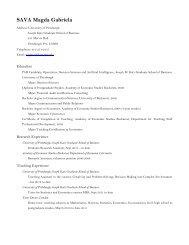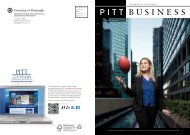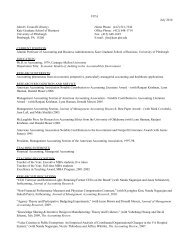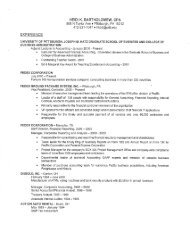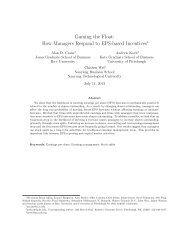Stuart L. Gillan, Jay C. Hartzell, Andrew Koch, and ... - Pitt Business
Stuart L. Gillan, Jay C. Hartzell, Andrew Koch, and ... - Pitt Business
Stuart L. Gillan, Jay C. Hartzell, Andrew Koch, and ... - Pitt Business
You also want an ePaper? Increase the reach of your titles
YUMPU automatically turns print PDFs into web optimized ePapers that Google loves.
model is consistent with the contention that firms caught cheating on CSR promises will earn<br />
lower profits, while more responsible firms will earn higher profits as a reputational premium to<br />
support good behavior. In contrast, the third Benabou <strong>and</strong> Tirole (2010) hypothesis is that CSR<br />
develops because corporate executives <strong>and</strong> boards are engaged in these policies for their own<br />
benefits. This implies a negative association between firm performance <strong>and</strong> CSR policies.<br />
Of course, as noted by Benabou <strong>and</strong> Tirole (2010), empirical analyses of such issues are<br />
subject to the problems of endogeneity, reverse causation, <strong>and</strong> non-mutual exclusivity of the<br />
hypotheses. Keeping these caveats in mind, as a first step in this line of inquiry, we focus on the<br />
associations between ESG <strong>and</strong> firm performance.<br />
In Table II we report the results of tests examining the association between a firm’s<br />
operating performance <strong>and</strong> its net KLD scores based on the individual components, E, S, <strong>and</strong> G.<br />
Our proxy for firm performance is return on assets, measured as the ratio of Earnings Before<br />
Interest <strong>and</strong> Taxes (EBIT) to Total Assets. We also include indicators for each Fama-French<br />
(1993) 48-industry classification, so the estimated effects are industry-adjusted. The primary<br />
focus is on the firm’s net KLD scores for environmental policies in Model (1), social<br />
responsibility policies in Model (2), <strong>and</strong> governance policies in Model (3). In all specifications,<br />
we control for firm size <strong>and</strong> the book-to-market ratio, include fixed year effects, <strong>and</strong> cluster<br />
st<strong>and</strong>ard errors by firm. Specifically, we test the following model:<br />
(1) EBIT/Assetst = + 1(ESG score)it + 2 ln(Market Value of Equityit-1) +ln(Market-to-<br />
Book)it-1 +i,t + i,t<br />
The results indicate a significant positive association between operating performance <strong>and</strong><br />
both the net environmental <strong>and</strong> governance scores. That is, firms that have stronger<br />
environmental <strong>and</strong> governance polices in place tend to have better operating performance –<br />
11




